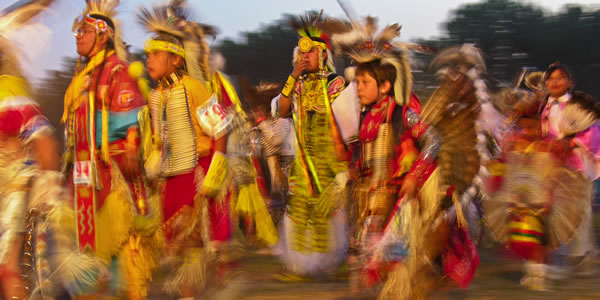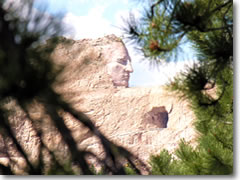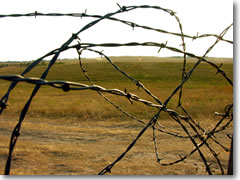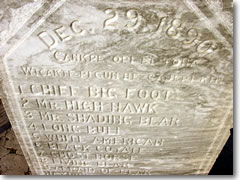Fake Cowboys, Real Indians

Crazy Horse, Wounded Knee, and a Lakota Sioux Pow Wow on the Pine Ridge Oglala Reservation in South Dakota
 The 2006 Oglala Sioux Pow Wow on South Dakota's Pine Ridge Indian Reservation.
The 2006 Oglala Sioux Pow Wow on South Dakota's Pine Ridge Indian Reservation.
I want to get one thing clear: I did not spill my frybread burger on an Indian princess.
It was a frybread taco, not a burger. I spilled it on myself. And, technically speaking, she was not a princess. Her name was Anna Diaz, and she was Miss Oglala Nation 2006.
She merely was dressed as an Indian princess.
Playing at Cowboys
It all started with Crazy Horse.
Our Boy Scout troop had abandoned our van for an afternoon horseback ride through the Black Hills of South Dakota led by Becca and Renae of Rockin R Rides (605-745-7868, www.rockingrtrailrides.com, $55 for a half-day ride).
Our goal was an overlook with peek-a-boo views of the 87.5-foot-high head (and 227-foot-long arm) of the Crazy Horse Memorial (www.crazyhorse.org), the Lakota Sioux warrior famous for his battle tactics at Little Big Horn (and for being smart enough never to sign a treaty with the white man) that is being carved out a nearby mountain—sort of a Native American answer to the giant presidential noggins 17 miles away on Mt. Rushmore (www.nps.gov/moru).
 The sculpture-in-process of Crazy Horse in South Dakota's Black Hills.
The sculpture-in-process of Crazy Horse in South Dakota's Black Hills.
The trail was beautiful, winding through forests of quivering aspen and ponderosa pine past nervous white-tailed deer and abandoned mica mines, but the mood was spoiled by an incessant buzzing in the near distance, like a plague of locusts bearing chainsaws.
It was the week leading up to the big August motorcycle rally in Sturgis , and southwest South Dakota was swarming with latter-day cowboys mounted on tens of thousands of blatting, spluttering, buzzing motorcycles. Though it was exciting to be surrounded by the bikers, after a few days we needed to escape.
We decided to take back roads into Badlands National Park (www.nps.gov/badl), through the Pine Ridge Indian Reservation , homeland to famous Sioux from Crazy Horse to Black Elk to Russell Means.
At the crossroads on the Rez where we should have turned left to head up into the Badlands, I looked at Stew and said, "You know, Wounded Knee is only a half an hour out of the way."
Serendipity at Wounded Knee
 The site of the 1890 massacre at Wounded Knee, Pine Ridge Indian Reservation, South Dakota.
The site of the 1890 massacre at Wounded Knee, Pine Ridge Indian Reservation, South Dakota.
I'm used to the boutique states of the northeast, so distances in the big, brash, sprawling West always deceive me.
The Pine Ridge Indian Reservation (www.oglalalakotanation.org) covers 1.7 million acres—much larger than, say, Delaware—and Wounded Knee was more like an hour and a half out of our way, but it was worth the detour.
I minored in American Indian Studies in college, an interest that began when my 11th grade history teacher, Dr. Fischer, gave me Dee Brown's seminal book "Bury My Heart at Wounded Knee." It recounts the events leading to the 1890 massacre of 300 Lakota—mostly women, children, and old men—by the Seventh Calvary at a place called Wounded Knee, which is now in the middle of Pine Ridge.
Pine Ridge is second largest reservation in the nation, home to around 20,000 members of the Oglala Sioux Tribe.
It's also the poorest county in the U.S., with an average annual family income of $3,700 and an unemployment rate pegged between 70 and 85%.
The Rez suffers from extremely high rates of alcoholism and diabetes—more than half the population over age 40 is diabetic—and the highest infant mortality rate in the nation.
Life expectancy for men is 48 years, for women 52.
All this perhaps helps explain why local tensions in the 1970s once again put Wounded Knee in the national spotlight.
In 1973, members of the American Indian Movement (AIM) occupied the community, the armed protest designed to attract news cameras and raise awareness of Indian rights and other issues related to the plight of Native Americans.
 The memorial to the 1890 massacre at Wounded Knee, Pine Ridge Indian Reservation, South Dakota.
The memorial to the 1890 massacre at Wounded Knee, Pine Ridge Indian Reservation, South Dakota.
Though no one was hurt during that 71-day standoff, the incident was but part of an era of violent factionalism that embroiled Pine Ridge throughout the early 1970s and culminated in the 1975 death of two FBI agents and one Indian during another shootout.
(The complex tale of scandal, conspiracy, and corruption behind that tragic era could keep Oliver Stone busy for years—though it was Michael Apted and Robert Redford who produced the documentary Incident at Oglala, as well as Thunderheart, a loosely-based-on-reality Hollywood version starring Val Kilmer.)
The Wounded Knee memorial (to the 1890 massacre) is in a tiny cemetery atop a hill surrounded by chain-link fence, with an AIM-run museum nearby providing a somewhat jumbled account of the dark days of the 1970s.
I tried to help the boys make sense of this complex, bloody, and largely untold history of the Plains as we crossed the road to browse some craft stalls. That’s where a woman selling beaded jewelry and leather medicine bags asked, "So, you guys here for the pow wow?"
Stew and I exchanged looks. "Er, what pow wow?"
Pow Wow
 The Grand Entry dance at the 2006 Oglala Lakota Nation Gathering on the Pine Ridge Indian Reservation, South Dakota.
The Grand Entry dance at the 2006 Oglala Lakota Nation Gathering on the Pine Ridge Indian Reservation, South Dakota.
The mercury was climbing back down from 100 degrees by 8pm when the Grand Entry of the 26th annual Oglala Lakota Nation Gathering started, luckily for us, an hour late.
Held on the dusty fairgrounds in Pine Ridge town, this was the biggest pow wow—or wacipi in Lakota—of the year.
There must have been 5,000 people there, maybe 50 of whom were white—mostly neighbors, plus a small groups of German tourists and the eight of us. Our suburban teenagers had clearly never experienced being in the minority before, and at first wandered around in a slightly panicked-looking clump.
But the Oglalas' welcoming attitudes—to say nothing of their delicious frybread—soon won the boys over, and we saw them buying dreamcatchers at the craft stalls, daring each other to hit on cute Lakota girls, and debating whether to enter the pitching contest, basketball games, and various races.
 Oglala Sioux men dressed to the feathery nines for their ceremonial dances at the 2006 Oglala Lakota Nation Gathering on the Pine Ridge Indian Reservation, South Dakota.
Oglala Sioux men dressed to the feathery nines for their ceremonial dances at the 2006 Oglala Lakota Nation Gathering on the Pine Ridge Indian Reservation, South Dakota.
I settled down near one of dozens of drum circles that circled the central arena to watch the dance competitions while announcers Chris Eagle Hawk and Pat Bad Hand kept up a play-by-play.
Half the men milling around were dressed as warrior chiefs and braves in buckskins, porcupine-quill breastplates, and jewelry of bison and elk bone or elaborate feather headdresses and bustles. Their ankles were shackled in bells that tinkled as they stomped their way through the traditional Grass Dance .
Hundreds of the women wore colorful skirts sewn with rows of close-set oblong bells—traditionally made from the rolled-up lids to snuff cans—that created a glorious sort of rain-like music when they shimmied past in the Jingle Dance .
They also jingled brightly wherever they walked, so you'd think I could have avoided the embarrassing collision with Ms. Oglala Nation. The Indian Princess just smiled at me beautifully before sweeping past.
The boys went to bed early, so they never knew that Stew discovered a rodeo on the far side of the fairgrounds, where we leaned on the fence and watched the bull-riders get thrown and trampled to the strains of popular rock songs being covered by a small band on the bed of a pickup.
Long after midnight, we made our exhausted way back across the fairgrounds, swishing through knee-length grass. The air was choked with dust backlit by a suffused orange glow from the surrounding lights leaving us lost in a confusion of pickups jouncing past and packs of kids on bikes, piled onto ATVs, or riding bareback two or three to a horse.
Finally, we found the van and our tents, pitched amidst a sea of Lakota tents and giant tipis, and fell asleep to the sounds of merrymaking and a late-night drum circle somewhere in the near distance.
 Oglala Sioux women performing the traditional Jingle Dance at the 2006 Oglala Lakota Nation Gathering on the Pine Ridge Indian Reservation, South Dakota.
Oglala Sioux women performing the traditional Jingle Dance at the 2006 Oglala Lakota Nation Gathering on the Pine Ridge Indian Reservation, South Dakota.
When You Go...
Pow wows great and small are held frequently across the Great Plains. Drumhop.com (www.drumhop.com) lists dates and contact info for gatherings in the Dakotas, Minnesota, Wisconsin, and Canada.
The Alliance of Tribal Tourism Advocates (www.attatribal.com) provides all sorts of information for visitors to all parts of the Great Sioux Nation.
Related Articles |
|
This article was by Reid Bramblett and last updated in June 2012.
All information was accurate at the time.
Copyright © 1998–2013 by Reid Bramblett. Author: Reid Bramblett.
